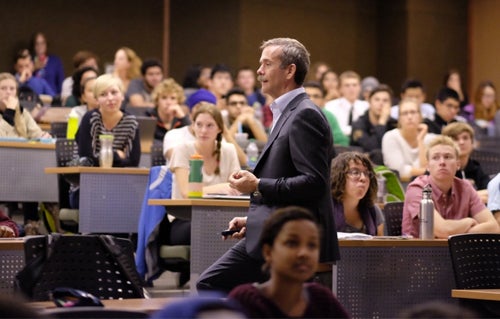
Chris Hadfield delivers first lectures to Waterloo students
Hadfield, a retired astronaut who has been around the world 2,600 times, told the students: “This is my very first day as a professor.”

Hadfield, a retired astronaut who has been around the world 2,600 times, told the students: “This is my very first day as a professor.”
By Sam Toman Faculty of EnvironmentCommander Chris Hadfield made his University of Waterloo debut as Professor Hadfield to geography and aviation students Friday afternoon.
The retired Canadian astronaut delivered his first surprise lecture of the afternoon to a third-year geography class on advanced remote sensing techniques. Hadfield described how he was able to snap photos of Earth while serving as commander of the International Space Station: “The countries aren’t colour-coded and north isn’t up,” Hadfield joked with the room of geographers.
Quizzing the room to see who could identify the various locations in his celestial photo collection, Hadfield lingered on one of the US/Mexico border. Farming techniques, city grids and irrigation patterns all change on the other side of a seemingly arbitrary line. “It’s amazing the amount of different information you can get from a photograph,” he said.

Hadfield’s three-year term as an adjunct professor at Waterloo is a cross-appointment to the Faculties of Science, Environment and Applied Health Sciences. Waterloo offers two undergraduate degrees in aviation, a Bachelor of Science and a Bachelor of Environmental Studies.
Hadfield’s next stop was across campus at St. Paul’s University College, where he gave a surprise presentation to a packed room of geography students fresh off their first midterm.
Once the excited chatter died down, Hadfield detailed the complex process by which his photographs were transferred from the International Space Station to NASA computers – including the laptop his popular tweets came from.
Noting he’s been around the world 2,600 times, Hadfield stressed the historical and scientific importance of photographs from space.
“The first pictures of the moon changed our perceptions of Earth,” he said, showing one of the first images ever taken of Earth from space. “Now you take it for granted, but in 1970 no one had ever seen anything like that. There is so much information in that.”
Moving on to images of active volcanoes, islands, and even the recent flooding in Calgary, Hadfield was clear about the important part photography like his plays in understanding our planet. “We can use this resource to make better decisions about the planet itself,” he said.
Karim El Sayed, a first-year aviation student left the lecture impressed and inspired. “I just came for the midterm. They suggested I stay, so I did,” said El Sayed. “It was useful, but mostly interesting. Not many people have the kind of experience he does.”
Hadfield’s final lecture of the day was to a class of upper-year aviation students, who have all already logged hundreds of hours of flight time. Hadfield, who is an accomplished military pilot, used the full two-hour lecture to share his passion for flying.
While answering technical questions, on topics such as lift vectors and landing distances, Hadfield’s personal advice and career experience resonated with the students.
“They used to say, ‘Why are you training to be a pilot, you’ll all be replaced by robots soon,’” said Hadfield. “That was even back in 1958. That still hasn’t happened. This job is too complex. There is too much at stake.”

Read more
Here are the people and events behind some of this year’s most compelling Waterloo stories

Read more
Meet the 14 exceptional students representing Waterloo’s newest grads

Read more
More than 100,000 children and youth from across the region are discovering the wonders of science and technology through the University of Waterloo
The University of Waterloo acknowledges that much of our work takes place on the traditional territory of the Neutral, Anishinaabeg, and Haudenosaunee peoples. Our main campus is situated on the Haldimand Tract, the land granted to the Six Nations that includes six miles on each side of the Grand River. Our active work toward reconciliation takes place across our campuses through research, learning, teaching, and community building, and is co-ordinated within the Office of Indigenous Relations.